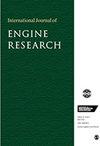单缸PFI发动机氢气燃烧实验研究
IF 2.1
4区 工程技术
Q2 ENGINEERING, MECHANICAL
引用次数: 1
摘要
同时减少温室气体(GHG)和标准污染物是当前内燃机发展的主要目标。氢燃料(h2)在这两方面都是最好的选择之一,因为它不会排放尾气中的二氧化碳,并且显著减少了发动机排放水平上的所有标准污染物。然而,优化氢燃烧以最大限度地利用燃料的特性是一项具有挑战性的任务,因为燃料的特性非常特殊。事实上,内燃机中的h2燃烧促进了一个非常清洁、快速和完全的燃烧过程,极低的HC、CO和PM发动机排放仅来自润滑油。使用稀燃推进和egr稀释燃烧策略可以显著提高制动热效率,并将NOx排放降至极低水平。为此,作者测试了一台0.5 L单缸发动机,该发动机具有优化的PFI布局和专用活塞碗外形,用于改装后的柴油发动机在SI模式下作为h2单燃料运行。在本文中,作者讨论了通过实验设计(DoE)技术广泛研究的主要发动机参数的影响,以及稀释和EGR对促进清洁和高效氢燃烧的影响,以推荐最有效的做法。本文章由计算机程序翻译,如有差异,请以英文原文为准。
Experimental investigation of hydrogen combustion in a single cylinder PFI engine
The simultaneous reduction of Green-House Gases (GHG) and criteria pollutants is the main target of current Internal Combustion Engines (ICE) development. Hydrogen (H 2 ) fueling is one of the best options available in both regards, as it does not emit tailpipe CO 2 as well as significantly abates all criteria pollutants already at engine-out level. However, optimizing hydrogen combustion in order to exploit the fuel proprieties at best is a challenging task due to the very particular properties of the fuel. In fact, H 2 combustion in ICE promotes a very clean, fast and complete combustion process, with extremely low HC, CO, and PM engine-out emissions stemming only from lubricant oil. The usage of lean-boosted and EGR-diluted combustion strategies can significantly contribute to raise the brake thermal efficiency and lower the NOx emission to extremely low levels. To this end, the Authors tested a 0.5 L single cylinder engine featuring an optimized PFI layout and dedicated piston bowl profile for a retrofitted Diesel operating as H 2 monofuel, in SI mode. In this paper, the authors discuss the effect of the main engine parameters, extensively investigated by means of Design of Experiments (DoE) techniques, as well as the effect of dilution and EGR to promote clean and efficient hydrogen combustion, in order to recommend the most effective practices.
求助全文
通过发布文献求助,成功后即可免费获取论文全文。
去求助
来源期刊

International Journal of Engine Research
工程技术-工程:机械
CiteScore
6.50
自引率
16.00%
发文量
130
审稿时长
>12 weeks
期刊介绍:
The International Journal of Engine Research publishes high quality papers on experimental and analytical studies of engine technology.
 求助内容:
求助内容: 应助结果提醒方式:
应助结果提醒方式:


